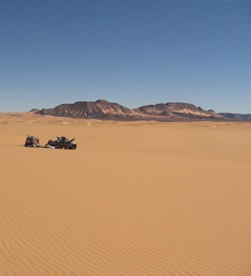
Desert exploration
There are two time-windows when Saharan fieldwork is possible: February-April, and October-December. During these months, the temperature does not normally exceed 30°C, although the nights can become very cold and windy. In April, ferocious sand storms become quite common.
If you don’t want to travel by camel (or walk!) then the only way to get about is by 4WD. An ideal set-up is a small group, comprising two or three vehicles: one for the geologists and equipment, and the other for food, fuel and – the most important of all – water. Small means flexible: any campsite can be moved and set up in very short time. Aspiring Saharan geologists should set up camp in daylight and never at night because snakes and scorpions make uncomfortable company in your sleeping bag. These desert inhabitants are some of most dangerous animals you might encounter. Snakes normally escape before you even see them. Scorpions are more problematic. They hide under rocks and do not move when you approach them. Rocks should always be moved with a hammer or a fully booted foot.
The other worrying issue is unexploded landmines, which are found not only at the borders to Chad and Niger but also in central Libya, north of the Tibesti Massif. It can be an unsettling experience to drive along a previously “forbidden road”, as marked on your official road map, as we did in April 2009. Finally - the intense sunlight makes it imperative to cover up in light-coloured clothes with long sleeves, a sun hat, and plenty of sunscreen. It is also important to drink small amounts of water at regular intervals, since dehydration leads to irreversible damage to internal organs.
Despite all of this, by following some simple rules and being aware of possible dangers, you can easily enjoy life in the desert - much of which is virgin geological territory with stunning scenery. After traditional Libyan stew and couscous, you will reflect on the day’s adventure with a glass of green tea. Sleeping in the open air on the desert sands, you will count shooting stars in the sky and during the long nights, plan the next productive field day in the Libyan Sahara.
Acknowledgements
This work is supported by the Libyan Petroleum Institute and the Earth Science Society of Libya, and funded by a consortium of subscribing oil and gas companies. All of them are gratefully acknowledged for their support of the Southern Basins of Libya study.